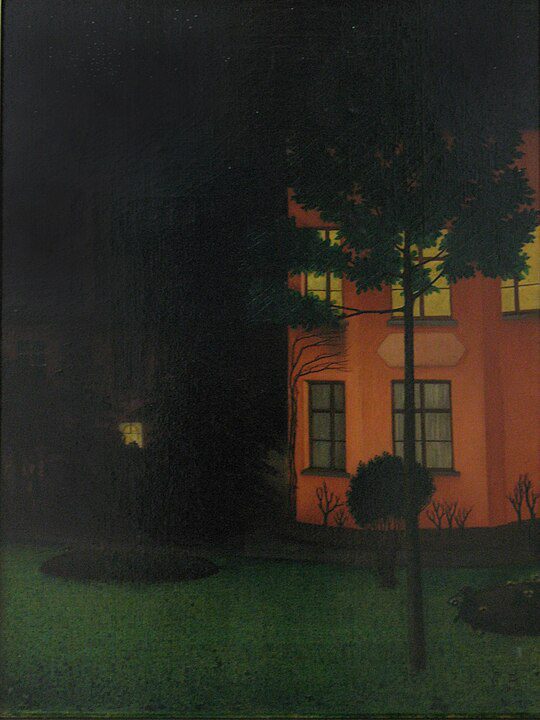
William Degouve de Nuncques, born on February 28, 1867, in Monthermé, Ardennes, France, is an intriguing figure in the Symbolist movement. Known for his ethereal nocturnal landscapes, Degouve de Nuncques’ works are windows into mystical realms, characterized by an atmosphere of dreamlike serenity and otherworldly beauty.
Born into a French aristocratic family, Degouve de Nuncques experienced a life of privilege. His family moved to Belgium when he was young, settling in the culturally rich Walloon region. This relocation was pivotal, exposing him to the burgeoning Belgian art scene and the influences that would shape his career.
Despite his aristocratic background, Degouve de Nuncques did not pursue a traditional academic art education. His artistic journey was largely self-directed, nurtured within the vibrant circles of Brussels’ avant-garde community. It was here that he became immersed in the Symbolist movement, which sought to express the mystical and spiritual aspects of human experience.
Symbolism, with its emphasis on the mystical, the emotional, and the dreamlike, had a profound impact on Degouve de Nuncques. He was particularly influenced by the works of Odilon Redon, whose use of color and fantastical imagery resonated deeply with him. The melancholic landscapes of Arnold Böcklin and the serene, almost ethereal scenes of Puvis de Chavannes also left their mark on his developing style.
Les XX and Artistic Development
A significant influence on Degouve de Nuncques’ artistic development was his association with Les XX (Les Vingt), an avant-garde group based in Brussels. This collective, which included notable artists like James Ensor and Fernand Khnopff, was crucial in exposing Degouve de Nuncques to a variety of artistic styles and ideas. Through Les XX, he encountered the innovations of Impressionism and Post-Impressionism, which he synthesized into his own Symbolist vision.
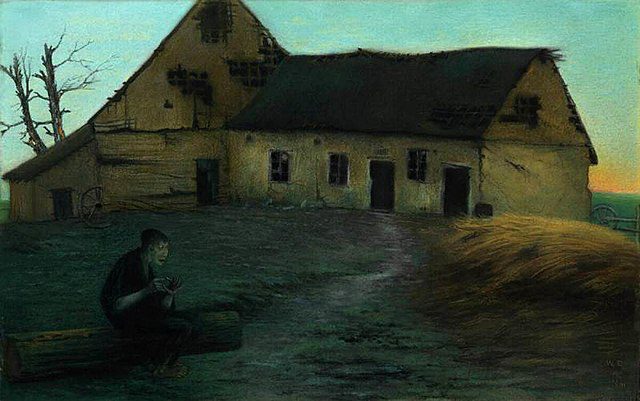
His friendship with Ensor and Khnopff was particularly influential. Ensor’s exploration of the macabre and the fantastical, and Khnopff’s meticulous, introspective approach to art, provided rich sources of inspiration. Degouve de Nuncques’ work from this period reflects a deepening engagement with the mystical and the surreal, moving away from the literal to the allegorical and the symbolic.
Signature Style and Themes
Degouve de Nuncques is best known for his evocative nocturnal landscapes. These paintings, often bathed in moonlight, create a sense of stillness and introspection. His use of color is meticulous, with a palette dominated by deep blues, purples, and greens, punctuated by the soft glow of moonlight. This creates a tranquil, mysterious atmosphere, inviting viewers into a world that exists between reality and dream.
One of his most celebrated works, “The Pink House” (1892), exemplifies his style. The painting depicts a solitary house bathed in an eerie pink light, surrounded by a dark forest. This work captures the essence of Degouve de Nuncques’ art: a dreamlike quality achieved through a careful balance of color and light.
Another notable work, “The Angels of Night” (1894), features angelic figures floating above a darkened landscape. This painting highlights his ability to create a sense of mystery and otherworldliness, blending the spiritual with the natural.
Nature in Degouve de Nuncques’ work often appears mystical and otherworldly. His landscapes feature forests, lakes, and mountains shrouded in mist and bathed in an ethereal light. These scenes evoke a sense of the sublime, encouraging viewers to contemplate the beauty and mystery of the natural world.
Major Works and Exhibitions
Degouve de Nuncques’ oeuvre includes numerous iconic works that highlight his unique vision. Apart from “The Pink House” and “The Angels of Night,” his painting “La Plage” (The Beach) (1894), depicting a desolate beach under a haunting sky, stands out. This work underscores his ability to evoke emotion through minimalist compositions.
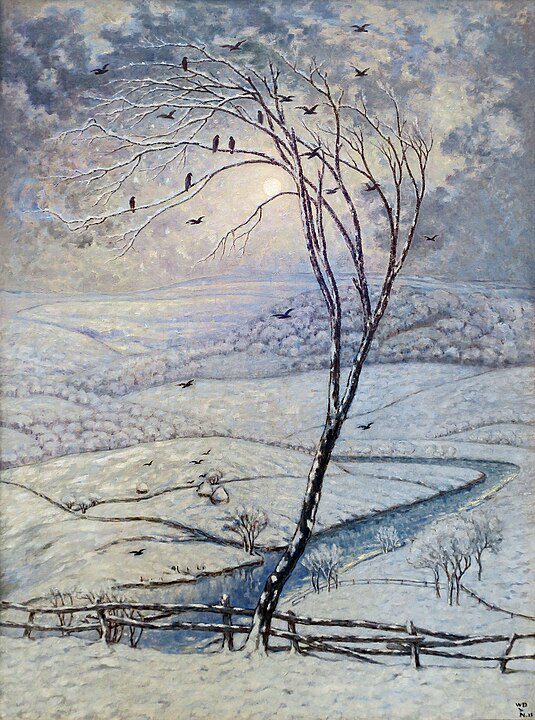
His work was well-received during his lifetime, with numerous exhibitions in Belgium and abroad. He participated in exhibitions with Les XX and its successor group, La Libre Esthétique, where his work was showcased alongside other leading Symbolist artists. His paintings were also exhibited in Paris, where they garnered praise for their originality and poetic quality.
Personal Life and Relationships
In 1894, Degouve de Nuncques married fellow artist Juliette Massin. The couple moved to the quiet village of Stavelot in the Ardennes, which provided a serene backdrop for his contemplative and mystical art. This rural setting allowed him to immerse himself in nature, a constant source of inspiration for his work.
Despite his success, Degouve de Nuncques led a relatively private and introspective life. He was known for his quiet demeanor and deep connection to the natural world. His relationship with Massin, who was also deeply engaged in the arts, was a partnership of mutual respect and inspiration.
In his later years, Degouve de Nuncques continued to explore the themes that had defined his career. His work remained focused on the mystical and the surreal, creating a body of work that stands as a testament to his unique vision. He passed away on March 1, 1935, leaving behind a legacy that continues to inspire and captivate audiences.
Degouve de Nuncques’ work has been the subject of renewed interest in recent years, with exhibitions and retrospectives celebrating his contribution to the Symbolist movement. His paintings are held in major museum collections, including the Royal Museums of Fine Arts of Belgium in Brussels and the Musée d’Orsay in Paris, ensuring that his legacy will endure for future generations.
Artistic Techniques and Innovations
Degouve de Nuncques was innovative in his use of color and light to evoke emotion and create atmosphere. His technique often involved layering translucent glazes to achieve a luminous quality in his paintings. This method allowed him to capture the subtle gradations of light and shadow that give his nocturnal scenes their characteristic depth and mystery.
His approach to composition was also distinctive. Degouve de Nuncques often employed unconventional perspectives and framing devices to draw the viewer into his mystical landscapes. This can be seen in works like “The Pink House,” where the house appears almost as a beacon of light amidst the encroaching darkness of the forest.
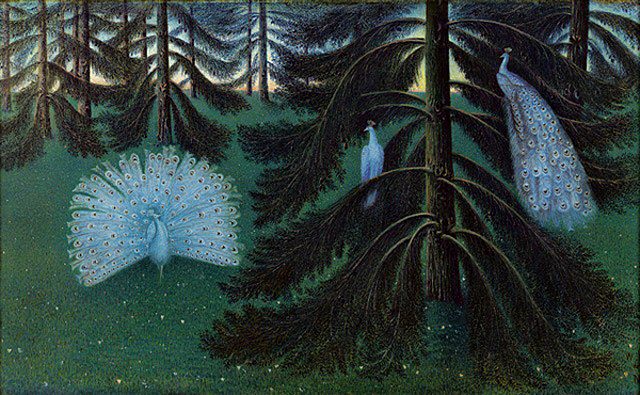
Degouve de Nuncques’ work must be understood within the broader context of the Symbolist movement, which emerged in the late 19th century as a reaction against the materialism and industrialization of the era. Symbolist artists sought to explore the spiritual and the mystical, using their art to delve into the realms of the imagination and the subconscious.
In this context, Degouve de Nuncques’ work stands out for its unique blend of naturalism and mysticism. His paintings are not merely depictions of the natural world but are imbued with a sense of the spiritual and the otherworldly. This duality is what gives his work its enduring appeal and emotional resonance.
Influence on Contemporary Art
Degouve de Nuncques’ influence can be seen in the work of contemporary artists who explore similar themes of mysticism and the surreal. His use of color and light to create mood and atmosphere has been particularly influential, inspiring artists to experiment with these elements in their own work.
His paintings have also been an important reference point for artists working in the fields of fantasy and science fiction. The dreamlike quality of his nocturnal landscapes, with their blend of the familiar and the fantastical, has inspired countless works in these genres, from literature to film and beyond.
Critical Reception and Scholarly Attention
While Degouve de Nuncques was well-regarded during his lifetime, his work has received renewed scholarly attention in recent years. Art historians have begun to re-evaluate his contribution to the Symbolist movement, recognizing the depth and originality of his vision.
Exhibitions and retrospectives have played a crucial role in this re-evaluation, bringing his work to the attention of a new generation of art lovers. These events have highlighted the unique qualities of Degouve de Nuncques’ art, from his masterful use of color and light to his ability to evoke emotion and mystery through his landscapes.
In the final years of his life, Degouve de Nuncques continued to paint, producing works that remained true to his Symbolist vision. He passed away on March 1, 1935, in Stavelot, leaving behind a rich legacy of art that continues to inspire and captivate audiences.
William Degouve de Nuncques stands as a unique and enigmatic figure in the history of art. His evocative nocturnal landscapes and mystical visions continue to captivate audiences, offering a glimpse into a world that exists somewhere between reality and dream. Through his masterful use of color and light, Degouve de Nuncques created a body of work that is both timeless and profoundly moving, inviting viewers to step into the mysterious and otherworldly realms he so beautifully depicted.
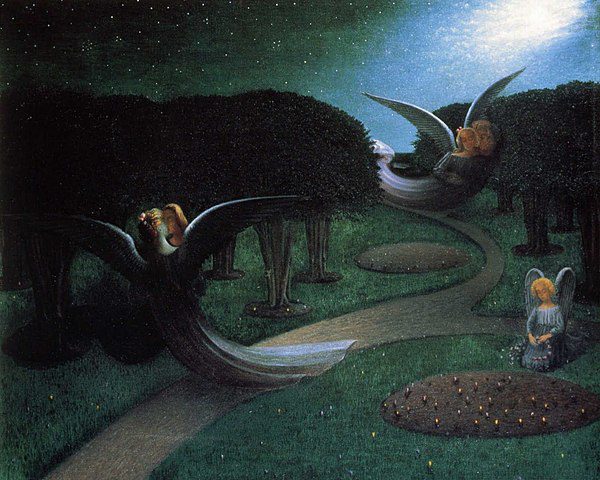
His legacy, preserved in the collections of major museums and celebrated in exhibitions and retrospectives, ensures that his contribution to the Symbolist movement will not be forgotten. Degouve de Nuncques’ art remains a testament to the power of imagination and the enduring appeal of the mystical and the sublime.




